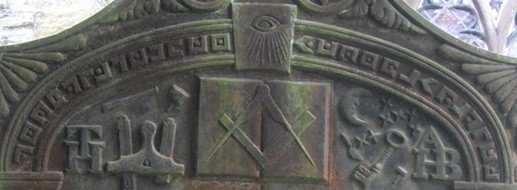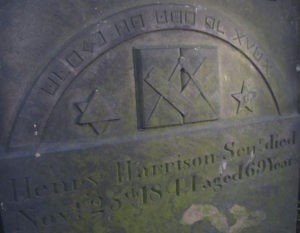Klaus Schmeh has just published a page on a previously unknown “Eliza” Masonic grave slab somewhere in Ohio, courtesy of Craig Bauer (Editor of Cryptologia, and who has a book on unsolved ciphers coming out next year).
Klaus’s commenters quickly worked out that it was actually the grave of Eliza Biehl (born 27th May 1862, died 2nd September 1915) buried in the Amboy Township Cemetery in Fulton, OH. It looks like this:
Klaus’s commenters quickly pointed out that the “John 3 – 16” on the left almost certainly refers to John 3:16, “For God so loved the world that he gave his one and only Son, that whoever believes in him shall not perish but have eternal life“.
The right hand side is a Masonic pigpen cipher (obviously), but with a twist: it is actually enciphered from right-to-left, and so reads:
NROB
72-YAM
2681
———–
DEID
2-TPES
5191
It was actually a very nice piece of tag-team code-breaking, well done to everyone involved. 🙂
I’ve mentioned one particular Masonic gravestone back in 2008: but it turns out there are plenty of others out there, a few of which Klaus covers in this post on his site.
But here’s one he missed: that of John Farmer Dakin:-
Here’s the plaintext if you’re too bone idle to work it out for yourself (it’s not hard, go on):
[—TRUSTINGODFOR—YOURSALVATION—]
Full bonus marks if you notice why this might give computer solvers a minor headache. 🙂
There are also various acrostic Masonic grave markings that occasionally turn up, such as FNDOZBTKC (which stands for “Fear Not, Daughter of Zion: Behold, The King Cometh”), and AHRHPCASDE (“And He reached her parched corn, and she did eat”).
Two More Masonic Gravestones…
But the real meat-and-two-veg of cryptic Masonic gravestones are pigpen cipher inscriptions: and so here are two more for you.
The first was from Dalkeith in Midlothian, and was cracked by amateur code-breaker Stuart Morrison. However, only really the headline of the story is on the web (i.e. no solution) and the image of the ciphertext isn’t really good enough to work with (in my opinion).
If someone has access to a better quality image of this, that would be a good help. 🙂
And finally, a Freemason called Henry Harrison had some pigpen on his gravestone.
Can you crack either of these? 🙂




For Harrison, using a pigpen outline where the 9-square clear grid contains ABC-DEF-GHI and dot grid contains RST-UVW-XYZ, and the letters in between are on the Xs, you get: STEPD HE SEE _C *NB* – anybody recognize this as a Masonic phrase?
(I keyed off the first two letters being sequential – ST and the repeated square as likely E)
Ernie Van Meter: doesn’t sound to me like you’ve yet nailed it, even though you’ve taken perfectly sensible steps. Mr Harrison’s pigpen may well be trickier than it looks, now I look a little more closely at it…
Nick – I agree something’s missing. The word “Udot square square” is haunting me though because if we assume plain English there are not many possibilities there. It’s also rules out a backwards reading.
Any idea what the Xs represent? Chi? I explored having that last word be “church” but couldn’t get anywhere with that. Are they just for emphasis? Does that show up in any other Masonic cipher?
Ernie Van Meter: the “Udot square square” is indeed the big puzzle, because the square doesn’t seem to tie in with normal pigpen layouts. But pigpen was also used to encode numbers (as we see in the Eliza Biehl gravestone), and people used all manner of different pigpen layouts / mappings, so there are many possibilities to consider here yet…
Seems like the squares are of two types – with or without an inscribed “x”. Squares 1, 2 and 4 have “x” square 3 don’t. “x” may mark another character used.
Also seems the signs are grouped in five groups of 5 – 2 – 3 – 2 – 4 signs.
Found some masonic pigpens here http://freemasonry.bcy.ca/texts/cyphers.html using another variety – English spells out GLORY TO GOB/D ON HIGH
@Ernie, how do you deal with the “>” and “V” which are used in the text on the Harrison grave stone with your 2 nine square grids?
And the two “X” really dont make sense for me either. Roman numbers maybe? (X=10)
Midlothian one – from St. Nicholas Church, Dalkieth – pics available here http://www.simpsonandbrown.co.uk/heritage-consultancy/interpretation/st-nicholas-buccleuch-dalkeith/ with picpen!
Text: PROUD MORTAL BEHOLD & LEARN
Carsten: thank you twice over, that’s really fantastic! I’ll put up an update to both these ciphers over the next few days. 🙂
Cheers nick
Actually not; just shows what’s possible if you’re keen on google-ing. 🙂
Carsten: regardless, thank you very much for using your Google-fu to find them both online. I’ll see if I can dig up any others to tax your considerable skills… 🙂
Carsten: can you find an online image for the (cryptic, but not Masonic) one mentioned here – http://www.historyfromheadstones.com/index.php?id=877 ?
Now that was a difficult one – pics here of both old and new headstones but taken at distance so not readable – http://www.historyfromheadstones.com/index.php?id=864
Also tried Google Earth but very few pics at all in the area.
Will try some more.
Carsten: I found it totally impossible to find any pictures at all, so I thought you’d appreciate the challenge. 😉
it may be of interedt that one of my keys shows a plaintext of some gillodgy strings
also the grave name links with the Mormon church jays zebidayze
start at 193 code number.
122 added=5
113=5+(2×5=10+5)=15=O the sum of 113 and twice the sum of the previous number
6=6+(2×5=10+6)=16=P
140=5+(2×6=12+5)= 17=Q
8=8+(2X5=10+8)=18=R
120=3+(2X8=16+3)= 19=S. This key also brings up old Poes name at code number 417
Nick – I’m not sure what you were meant about the square doesn’t fit in with normal pipgen alphabets – isn’t the square almost always E? as E is the fifth letter out of the first nine so it is going to end up in the center in almost any orientation you fill out the grid.
This thing just really *feels* like a simple English phrase but I just can’t make it work.
I did some searching through the KJV using regular expressions (as some of the other examples are Bible verse snippets) to find phrases that would match the letter pattern and didn’t find anything compelling. However this method wouldn’t match verse paraphrases.
Ernie: did you see this – http://ciphermysteries.com/2016/03/31/cryptic-masonic-gravestones#comment-342106
Carsten – re: the inscribed X – my guess is that’s an artifact of the tools used to make the larger symbols? (i.e. it is a leftover centering mark) Just a hunch though.
Nick – the spam filter keeps eating my posts – clearly there is a need for somebody to write a Cipher Sympathetic Spam Filter 😀
Ernie: the spam filter doesn’t like URLs, but if you put a space in place of the first ‘:’ and the last ‘.’, I’ll reassemble the link when I moderate up the comment.
Piper – my assumption with the V and the < is that the Pigpen is of the type described in the wikipedia article ( http://en.wikipedia.org/wiki/Pigpen_cipher ) (which uses two 9 square grids and two X grids) and not the kind where all the letters are on a 9 square grid. With A-I on one 9 square grid, and R-Z on the other, and then J-Q on the X grids you can either get STEPD HE SEE EC *NS* or STELD HE SEE EC *JS* – but neither of these makes a lot of sense.
Nick – ahh! I assumed the spam filter didn’t like the nonsense words. 😀
Did anybody try Latin? I could see this being a Latin phrase.
Hallelujah! And GLORY TO GOD ON HIGH – because that is what it says! Thanks Carsten – I took a look at your link – check out the “Another variety – English” key. I think you were also right that the square with the x is the equivalent of “square with two dots”
And now I feel like an idiot because you already solved it. 🙂 Oh well, it was a fun search…
Ernie: I did try to tell you… =:-o
Nick and Carsten – my apologies, when I read Carsten’s comment above I read the top half and assumed the link was to a different gravestone. Carsten well done, sorry for being an ass.
I am glad I didn’t go so far as to write a pigpen brute forcer (assuming that letters were assigned to grids in some order) – since this one in effect breaks normal pigpen cryptanalysis by semi-randomly assigning the letters. Good to know in the future not to make that assumption…
Only just saw the post – but yes the Masonic grave of Henry Harrison (my great-great-great-great uncle) does say ‘Glory to God on High’. It’s a lovely grave, and I’m now I the same lodge as he was in.
http://www.dr-david-harrison.com